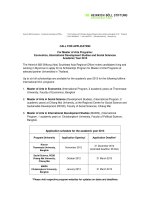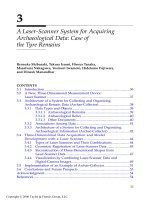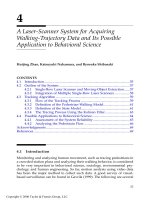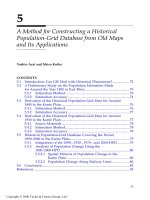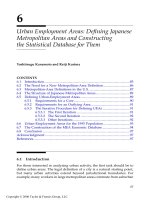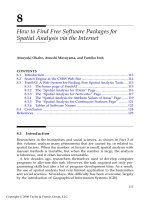The effectiveness of financial and accounting internal operation control of the faculty of humanities and social sciences, Khon Kaen university
Bạn đang xem bản rút gọn của tài liệu. Xem và tải ngay bản đầy đủ của tài liệu tại đây (474.22 KB, 9 trang )
THE EFFECTIVENESS OF FINANCIAL AND ACCOUNTING
INTERNAL OPERATION CONTROL OF THE FACULTY OF
HUMANITIES AND SOCIAL SCIENCES, KHON KAEN UNIVERSITY
Phirada Jongsatidrak
Sukhum Wasuntarasophit
Faculty of Humanities and Social Sciences, Khon Kaen University
Abstract
This study investigated the effectiveness of financial and accounting internal control
of the Faculty of Humanities and Social Sciences, Khon Kaen University as well as
proposed methods for improving such operation. The participants in this study were
twenty-three people, including (1) three administrators, (2) three financial officers study
were twenty-three people and (3) seventeen counting Committees. The questionnaires were
used to collect data, and the collected data were analyzed by descriptive statistics. The
overall internal control assessment result based on COSO concept was at the low level.
When considering each component, the results were revealed as follows. The first
component which was the internal environment was at the moderate level. The second
component which was the risk assessment and the third component which was the control
activities were at the level of needed to be improved. The fourth component which was
information and communication was at the moderate level. The fifth component which was
monitoring and evaluation was at the low level. Although the results of the evaluation of
the first component which was internal environment and the fourth component which was
information and communication were at the moderate level, they were still needed to be
improved and developed based on COSO concept for better financial processes of the
Faculty of Humanities and Social Sciences.
Keywords: financial and accounting internal control ,internal control assessment
result based on COSO
1. Introduction
1.1. Background and statement of the problem
Finance and accounting section, the Faculty of Humanities and Social Sciences of
Khon Kaen University, is to administer the faculty‘s treasury and manage budgets for
effective disbursement. Specifically, it deals with financial planning, generation of income
and expense reports, the payment of an advance, financial auditing and monitoring of
documents of the faculty staff (Faculty of Humanities and Social Sciences, 2012). Apart
from that, it regulates disbursement of all programs and all projects of those programs,
offer some advice as well monitors the operation related to finance and accounting. In
doing so, the finance and accounting section‘s operation complies with laws, rules and
regulations of Khon Kaen University Act B.E. 2558, Section 4 on Accounting and
926
Auditing (Khon Kaen University, 2012). In addition, it is obliged to manage the internal
control in accordance with State Audit Commission‘s regulation of the establishment of
internal-control standards B.E. 2544.
In relation to internal control auditing of the Faculty of Humanities and Social
Sciences, it consists of two aspects: university auditing and self-assessment report (SAR).
During the past ten years of auditing from 2007 to 2016, university auditing showed that
there were serious issues of disbursement, conserving and sending money to the treasury in
2011 as well as non-transparent internal control from 2008 to 2010, which affected the
faculty‘s administration and caused financial damage. In the meantime, the self-assessment
report found that the effective internal control required the assessment of the internal
control for treasury administration, particularly related to disbursement, conserving and
sending money to the treasury.
As can be seen, it can have effects on the operation of finance and accounting
section of the Faculty of Humanities and Social Sciences. Thus, the present study aimed to
investigate the effectiveness of the internal control of finance and accounting and to
propose the methods for the effective internal control. In particular, it focused on the
disbursement system, the systems of conserving and sending money to the treasury.
1.2. Purposes of the Study
According to general background, the research has two purposes, those are:
1.2.1 To study the efficiency of financial and accounting operation control of
Faculty of Humanity and Social Sciences, Khon Kaen University.
1.2.2 To suggest a model for improving the efficiency of financial and accounting
operation control of Faculty of Humanity and Social Sciences, Khon Kaen University.
1.3. Anticipated Benefits
According to the purposes of the study, it is expected that the research will provide
benefits to the learners as following:
1.3.1 The research could provide knowledge about improving the efficiency of
financial and accounting operation control, especially on payment system, savings system,
and money sending system of Faculty of Humanity and Social Sciences, Khon Kaen
University. In addition, the given knowledge could be the guideline for maximizing
faculty‘s financial and accounting effectiveness.
1.3.2 The learners acknowledge the improving the efficiency of financial and
accounting operation control of Faculty of Humanity and Social Sciences, Khon Kaen
University applying and following the concept of COSO, which could benefit to the
development of mindset for further improvement,
1.3.3 The learners have the guideline for financial and accounting operation to
reduce operation errors and to improve the operation effectiveness.
927
2. Method
2.1.Research Framework
This research investigates the assessment of the efficiency of operation control
within the organization including payment system, savings system, and money sending
system of Faculty of Humanity and Social Sciences, Khon Kaen University. The
investigation also provides the guideline for performance improvement of operation
control of Faculty of Humanity and Social Sciences, Khon Kaen University corresponding
to the COSO framework as following:
2.2Content framework — In this study, the researcher has compared the data
collected from internal financial and accounting operation control of Faculty of Humanity
and Social Sciences with 5 components of COSO framework: 1) Internal environment 2)
Risk Assessment 3) Controlling Activities 4) Information and Communication 5)
Following up as well as the concept of internal control for developing this research model
and guideline.
2.3 Target group framework — The population of this study is 24 people who
related to financial and executives which are Dean of Faculty of Humanity and Social
Sciences, Associate Dean for Administration, director of financial and accounting, and
cash counting directors.
2.4 Time Scope — the period of the study is January 2017 — January 2018.
3. Results
3.1. Research Methodology
The study of ―The Efficiency of Financial and Accounting Internal Operation
Control of Faculty of Humanity and Social Sciences‖ aims for probing efficiency of
financial and accounting internal operation control of Faculty of Humanity and Social
Sciences Khon Kaen University and suggests the guideline for improving the efficiency of
financial and accounting internal operation control of Faculty of Humanity and Social
Sciences Khon Kaen University following COSO internal control. The research is
qualitative research which the researcher has set the method and process as following: 1)
Population and Target group 2) Research Tools 3) Data Collection 4) Data Analysis.
3.2. Population and Target group
1.1 The population of this research is the group of people involving in financial system,
which includes payment system, money keeping, and money sending, 24 people consisting of 3
faculty‘s executives, financial staffs 3 people, and 18 cash counting directors.
1.2 Target Group of the research are 24 people i.e.
1) Three executives of Faculty of Humanity and Social Sciences
2) Three financial staffs
3) 17 cash counting directors
928
Table 1. Population and Target Group
Type
Executive
Financial Staffs
Position
Amount
Total
(person) (person)
1. Dean
1
2. Associate Dean
1
3. Head of Office
1
1. Finance and Accounting Analyst
3
3
11
17
Cash Counting Directors 1. Educator
2. General Officers
5
3. Policy and Strategy Analyst
2
4. Staffs
3
5. International Relations Officers
2
Total
29
3
23
3.3. Data Collecting Tools
The tools for collecting data is questionnaire which has its creating process as
following:
1.1 Structured Interview questionnaire was used in this research data collection as
shown below
1.2 The questionnaire was created under the concept of State Audit Office of the
Kingdom of Thailand evaluation, theory and studies related to the concept of COSO to
decide the structural interview questionnaire of Financial and Accounting Internal
Operation Control.
1.3 Structured Interview was designed to be consistent with the objective of the
study composed of money receiving, money keeping, and money sending in accordance
with COSO internal operation control. The main points of the questions are:
The first point is the questions about the internal control of money receiving, money
keeping, and money sending of Faculty of Humanity and Social Sciences.
The second point is the questions about COSO internal control assessment
consisting of 5 factors i.e. 1) internal environment 2) risk assessment 3) controlling
activities 4) information and communication 5) following up
1.4 The questionnaire is checked by experts which are independent study advisor,
thesis defense committee, and Faculty executive to consider whether the questions are
appropriate, complete, and consistent with the objective of the study.
929
1.5 Adjusting the incomplete part of the questionnaire according to experts‘
suggestions and sending to the experts to recheck the questionnaire again. Then, the
questionnaire is going to be prints to collect the data.
3.4. Data Collection
The data will be collected to study about the assessment of internal operation
control of receiving money, money keeping, and money sending of Faculty of Humanity
and Social Sciences, Khon Kaen University according to the COSO internal operation
control. The process has been divided into two parts as following:
3.1 Primary Data is the directed collected data from target group which the
researcher utilizes the method as following:
1) Asking for permission to meet the faculty Dean to explain the objectives and the
research procedure. The process of data collecting must have the access to data givers and
their cooperation including the data of the assessment of internal operation control of
receiving money, money keeping, and money sending of Faculty of Humanity and Social.
1.1) Contact to the data providers for making an appointment
1.2) Meet the data providers according to the appointment. In the process of data
collecting, researcher is going to begin with the first question in the questionnaire to the
last question. The model of the interview is described below:
2) In the interviewing with the executives, it is person-to-person interviewing
which the researcher is the asker, then write the answers to the questionnaire
3) In staffs interviewing, the staffs are gathering to the meeting room, then the
researcher asks them and let them write the answers to the paper themselves.
3.1 The data collected from the interviewing; the research is going to fill them to
the table to make the result of the process and have them checked by the committee.
3.2 In order to double check the correctness of the answers, the researcher is going
to make a meeting consisting of all of 3 groups before analyzing the data.
3.3 Secondary data is the data gathered from the study of concept, theory and
related papers. The data related to the assessment of internal operation control of receiving
money, money keeping, and money sending of Faculty of Humanity and Social.
3.5. Data Analyzing
In data analyzing, the analyzed data will be primary data which was sorted into
table by interviewing points combined with secondary data from the study of concept,
theory and related papers. Apart from that, the internal controlling according to concept of
SOCO. The analysis is followed the research objectives which are to assess and to suggest
the guideline for internal operation control of money receiving, money keeping, and money
sending for the Faculty of Humanity and Social Sciences. The analyzing points are:
First point: Analyze the internal control of money receiving, money keeping, and
money sending for the Faculty of Humanity and Social Sciences. The analyzed data comes
930
from interviewing in part 1 using average and percentage. If the outcome is above 80%, it
means the faculty has a good internal control.
Second point: Analyze the internal control of the Faculty of Humanity and Social
Sciences according to the concept of COSO in five components. The analyzed data comes
from the second part of the interviewing using average and percentage. If the outcome is
above 80%, it means the faculty has a good internal control.
There are five level of assessment i.e.
(1) 100% - 90% means very good
(2) 89% - 80% means good
(3) 79% - 70% means moderate
(4) 69% - 60% means low
(5) 69% - 0% means improvement needed
Third point: Compare the controlling in part 1 and part 2 for finding the differences
before suggesting the guideline for internal financial operation control according to COSO.
Moreover, in comparison, the researcher will stick to five components of SOCO concepts
to be control group and then compare them with the collected data.
4. Discussion and Conclusion
4.1. Research Summary
Form the assessment of internal operation control of money receiving, money
keeping, and money sending of Faculty of Humanity and Social, Khon Kaen University,
the result overall is Low (x = 24.2, SD.= 9.3). When separately considering the assessment
of internal operation control by COSO factors, it was found that the factor 1 ‘Internal
environment‘ of internal operation control is low (x = 5.7, SD.= 2.7). The factor 2 ‗Risk
assessment‘ of internal operation control is good (x = 8.8, SD.= 3.2), the factor 3
‗Controlling activities‘ of internal operation control is low (x = 4.6, SD.= 2.9), the factor 4
‗Information and communication‘ of internal operation control is moderate (x = 2.8, SD.=
1.2), and the factor 5 ‗following up‘ of internal operation control is improvement needed (x
= 1.5, SD.= 1.4)
However, the overall result of the assessment of internal operation control of
financial and accounting according to the concept of COSO internal operation control is
low (x = 19.9, SD. = 12.7) When separately considering the assessment of internal
operation control by COSO factors, it was found that the factor 1 ‘Internal environment‘ of
internal operation control shows x = 11.7, SD.= 6.5. The factor 2 ‗Risk assessment‘ is x =
1.7, SD.= 3.0, the factor 3 ‗Controlling activities‘ is x = 2.7, SD.= 2.4, the factor 4
‗Information and communication‘ of internal operation control is moderate x = 2.7, SD.=
1.5), and the factor 5 ‗following up‘ of internal operation control is low (x = 1.6, SD.= 1.3)
4.2. Discussion
(1) Internal environment, in this study consists of honesty and morality aspect,
knowledge aspect, skill, staffs‘ capability, cooperation of executives and committee aspect,
931
executives‘ management aspect, organization structure aspect, HR aspect, and obligation
aspect. It was found that the result is going in the same way as research of Nussaba
Krobkrong (2013) and Anurak Pakdee (2013) which adopts the seven aspects to be the
framework. In addition, in the honesty and morality aspect, it is in the ‗should improve‘
level (53.6%) as well as the aspect of staffs‘ knowledge, skill, and capability is in low
(63.5%) agreeing with Nussaba Krobkrong (2013) and Anurak Pakdee (2013).
(2) Risk assessment, there are three aspects to be considered i.e. addressing risk,
analyzing risk, and risk management which is similar to Anurak Pakdee (2013) and
Deemai Intarapanich (2008)
(3) Controlling activities, in this component, the result is similar to the research of
Pairoj Damrongsak (2010) and Anurak Pakdee (2013) which suggest that there have to be
consisted of 1) Determined systematic controlling activities 2) Determined the standard or
policy and process 3) Determined investigating process 4) Determined the assessment
controlling.
(4) Information and communication, there are four points in this component
covering main two contents including 1) Correct, complete, and up-to-date information
help eliminate the weak links within the internal control which is similar to Kittipong
Pochanasombut (2014) and 2) the communication allows staffs to communicate effectively
rendering the staffs know their role and their duty about the controlling which is going the
same way as of Nussaba Krobkrong (2013)
(5) Following up and assessment, the questions in this component are consisted of
three points: 1) The faculty continually and consistently follows up and assesses of internal
operation control 2) The faculty allows the internal operation checker to assess and report
directly to the executives 3) The executives acknowledge the flaws and fix them
immediately. The result is alike to Thidaporn Inchum (2011) and Pairoj Damrongsak (2010)
which are included 1) Follow up system of internal management system 2) Internal operation
control committee 3) following up and fixing detected problems 4) financial data correctness
affirmation 5) responsibility and punishment of the committee when the error occurs.
5. References
1.Comptroller General's Department, Ministry of Finance. (2004). Code of Conduct
for Internal Controlling System in Government’s Offices. Bangkok: Internall Controlling
Development Department, Accounting and Internal Investigation Office, Comptroller
General's Department, Ministry of Finance.
2.Kittipong Pochanasombat. (2014). Internal Controlling System Evalution by
Using COSO Concept: Case Study of the Organization in Office of the Permanent
Secretary, Ministry of Education. Thesis in Master of Political Sciences, Public and Private
Sector Management Program, Graduate School of Public Administration, Burapha
University.
3.Auditor General of Thailand Committee. (2004). Instruction: Making a Report of
Internal Controlling according to Rule of Auditor General of Thailand Committee in
932
Making the Standard of Internal Controlling 2001. 2nd Edition. Bangkok: Office of the
Auditor General of Thailand.
4.Faculty of Humanities and Social Sciences. (2014). Faculty of Humanities and
Social Sciences’ Annual Plan. Khon Kaen: Faculty of Humanities and Social Sciences,
Khon Kaen University.
5.____. (2017), Adminitration Structure of Faculty of Humanities and Social
Sciences. Khon Kaen: Faculty of Humanities and Social Sciences, Khon Kaen University.
6.Jaruwan Pratheepawanich. (2013). Internal Controlling System Assessment of
Provincial Electricity Authority by Using CIPP Assessment Model.
7.Thesis in Master of Business Administration, Executive Business Administration
Program, Graduate School of Commerce, Burapha University.
8.Jittrakan Somsuk. (2009). Case Study: Internal Controlling Assessment in
Producting and Selling Chemical Products for Agriculture. Thesis in Master of Business
Administration, Kasetsart University.
9.Jenjira Ratana. (2013). Financial or Accounting Internal Control Assessment of
Department of Lands in Lampoon Province, Indepentdent Study in Master of
Accountancy, Accountancy Program, The Graduate School, Chiang Mai University.
10.Chonlakarn Kaewkampa, Captain. (2009). Internal Controlling Assessment of
Office of the Army Comproller. Thesis in Master of Business Administration, Kasetsart
University.
11.Charoen Jetsadawan. (2003). Priciples and Practices of Internal Controlling
System, Bangkok: Pordee. Cherdchai Meekham. (2001). Finance Office Practices,
Bangkok: Sam Charoen Panit (Bangkok). Deemai Intarapanich. (2008). Internal
Controlling Conditions and Issues in the Schools in Sakon Nakhon Educational Service
Area Office 2. Thesis in Master of Education, Education Administration Program,
Graduate School, Sakon Nakhon Rajabhat University.
12.Stock Exchange of Thailand and the Institute of Internal Auditors of Thailand. (2005).
13.Elements of COSO ERM. date retrieved 19 April 2015, from www.set.or.th
14.Thidapron Inchum. (2011). Issues in Accountancy Work and Internal Control in
Village’s Fund and Urban Community in Jomthong District, Chiang Mai. Thesis in Master
of Accountancy, Accountancy Program, Graduate School, Chiang Mai University.
15.Narissara Kaewsaenmuang. (2011). Knowledge of System Planning and Internal
Control Evaluation of Chiang Mai’s Government Officer. Research in Master of
Accountancy, Accountancy Program, Graduate School, Chiang Mai University.
16.Nonglak Banlert. (2014). Finance and Accountancy’s Internal Control
Evaluation in the Office of Strategy Management, Ministry of Interior. Independence
Study in Master of Accountancy, Graduate School, Chiang Mai University.
933
17.Busaba Krobkrong. (2013). Internal Controlling System Development of
Finance, Accountancy and Supplies of Lampang College, Thesis in Master of
Accountancy, Accountancy Program, Graduate School, Chiang Mai University.
18.Piyaporn Bundasak. (2012), COSO Internal Controlling System in Account:
Case Study of Health Fund. Thesis in Master of Internal Auditing, University of Thai
Chamber of Commerce.
19.Pairoj Damrongsak. (2010). The Study of Internal Controlling System
Management Issues in Basic Education Schools,
20.Khon Kaen Educational Service Area Office 1. Thesis in Master of Education,
Education Management Program, Graduate School, Surindra Rajabhat University.
21.Khon Kaen University. (2004). Internal Controlling System Guideline, Khon
Kaen University, Khon Kaen University.
22.______. (2011A). Reporting Guideline of Khon Kaen University‘s Internal
Control. Khon Kaen: Khon Kaen University.
______. (2016). Internal Audit Report of Budget Year 2010-2016, Khon Kaen:
Office of 23.Internal Auditing, Khon Kaen University.
24.Wantana Duangmahasorn. (2010). Report of COSO Internal Control and Internal
Controlling System of Rasananda Resort, Koh Phangan, Thesis in Master of Business
Administration, Kasetsert University.
25.Suwalee Dechaprab. (2015), Operation Assessment Result of Internal
Controlling System of Tasala Municipal District, Chiang Mai. Independent Study in
Master of Public Admistration Science, Graduate School, Chiang Mai University.
26.State Audit Office of the Kingdom of Thailand. (2009). Guideline: Internal
Controlling System Planning and Assessment, Bangkok: System Four Company Limited.
27.Anurak Pakdee. (2013). Internal Controlling Model Study in Accountancy and
Finance Depertment, Finance Division, Chandrakasem Rajabhat University.
28.The committee of Sponsoring Organizations of the Treadway Commission
(COSO). (1992). COSO Concept. Retrieved January 20, 2016, from .
934

